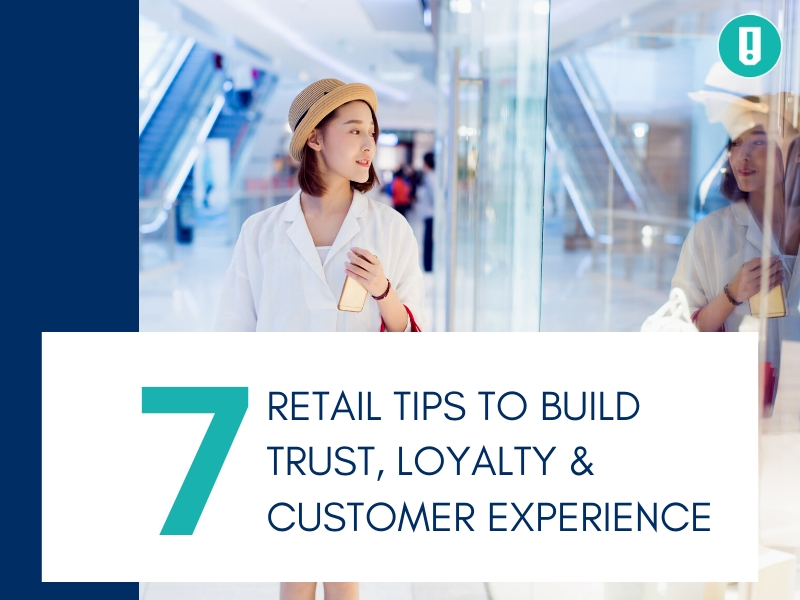How Creative Signware, Custom Displays and Technology Can Help
Retailers face many challenges in the changing economy. When it comes to visual merchandising, the traditional focus has been on using physical fixtures and displays and visual strategies to drive sales. However, today there is a powerful emphasis on less tangible aspects of retail such as trust, loyalty and customer experience.
The Importance of Trust, Loyalty & Customer Experience in Retail
Of course, important qualities such as trust, loyalty and customer experience have always been an important part of retail. However, before technology took over the world, retailers would likely develop these invaluable attributes through great service, quality products, competitive prices and a personal touch.
These fundamentals are still essential to the retail experience. But an important difference is well-explained in the “Retail CX Trends Report” issued by customer experience (CX) innovator InMoment, which opens with the following observation:
“In the age of what McKinsey & Co. calls the ‘experience economy,’ retailers are faced with a challenge: They must innovate the products and services they offer while also creating and maintaining a customer experience that will keep customers both trusting and loyal in the face of endless options.”
InMoment backs up this statement with compelling data from a survey of 1,300 U.S. consumers who shared insight about “the state of trust and loyalty, as well as customer perception about retailers’ attempts to offer more experiences versus simple transactions.”
For example, 88% of respondents said that trust is “extremely important” when deciding where to shop, with “delivering what they promised” being the top pick for what actions retailers could take to earn (and keep) customers’ trust. Trust in the retail world means a number of different things, from having all advertised items in stock to keeping customer data and private information safe.
Another important consensus from the survey, one that tracks with today’s conventional wisdom, is this:
“Consumers crave experiences, not just purchases. Even simple transactions can be meaningful, but consumers appreciate when brands make small efforts to make a transaction feel like more than a generic exchange. There’s a lot of good news for brands in these findings.”
As for customer loyalty, retail software innovator Lightspeed says it is a quality that translates directly into dollars and cents:
“Loyal customers are worth more. They spend more money, more frequently and cost about 7-10 times less to keep than it does to acquire a new customer. On average, repeat customers spend over 60% more per transaction than new customers. In other words, nurturing a loyal customer base makes good business sense and should be an integral part of any retailer’s strategy.”
Loyalty also translates to vitally important word of mouth, as new generations of influencers and brand ambassadors are now integral to the retail economy.
Tips for Enhancing Trust, Loyalty and Customer Experience
So, is it possible for retailers to use traditional merchandising apparatus such as retail displays, fixtures and signware to build trust and loyalty, and deliver superior customer experience? Absolutely.
Here are some tips and strategies:
1. Keep Signware Accurate and Up to Date:
Enticing a customer with signware that offers promotions or products that, they come to find out, are no longer available is a surefire recipe for customer negative customer experience. A disappointed customer will far less likely to return to shop with you.
Easy-to-change signware can help the customer trust that the imagery and promotions you’re showing properly reflect what you have available in the store. In addition to ease of use for your staff, refreshing your creative collateral is a great way to continually entice and delight customers.
2. Use Signware to Signal Exclusivity:
Retail FOMO (Fear of Missing Out) is a very real phenomenon that can be used in retail visual messaging. Using signage to advertise deals like “available in-store only” or “limited inventory” can pique interest and encourage curious shoppers to pop in to your store (if the sign is outside) or make a particular purchase (if the sign is inside).
You can also use signage to highlight and promote the products that are your “most-loved” or that you know to be “customer favorites.” This not only suggests to loyal customers that you pay attention to them and their behavior, but also helps educates all customers on items that are important to your brand.
3. Grab attention with light:
It’s a well-established fact that the human eye is naturally attracted to light. By incorporating illuminated signage like LED lightboxes, you can take advantage of this biological fact to attract customers into your store or to catch their attention once they’re inside.
4. Use your window display to your advantage:
Your window display is your brand’s “first impression” with passers-by and a great, creative way to show your brand’s personality as well as key products you have to offer. Customers appreciate creative window displays and retail visual merchandisers love putting together displays that deliver a “wow” factor. Window display updates can also offer CX value for loyal customers who look forward to the creativity and thought put into the windows of their favorite retailers.
When planning your window display, focusing important elements at eye-level to pedestrians is recommended, but be sure not to neglect the rest of the available space by incorporating different types of signage and display options for a top-to-bottom attention grabber.
5. Spread the Word About Your Loyalty and Rewards Programs:
If you offer loyalty or rewards programs, prominently displaying the value of such programs is a great way to spread the word and drive participation. Knowing they have the opportunity to earn deals and discounts could encourage shoppers to connect more closely with your brand.
6. Strategically Use Custom Retail Displays:
Custom retail displays can be used for a variety of strategic purposes. Here are just a few:
- Try-and-buy displays that invite customers to interact with select products can lead to a fun, engaging experience and even encourage customers to spend more time in your store.
- Branded Displays integrated with logos or other brand identity elements such as color schemes and typography can subtly, or overtly, draw attention and awareness to your brand. They also offer an opportunity to add a creative touch that helps showcase your brand’s personality.
- Grouped Product Displays have long been used by retailers to help customers find items that are meant to be worn or used together. The goal is to use your creativity to devise grouped product displays that inspire shoppers to imagine themselves wearing or using the products — and then purchase them.
7. Take Advantage of Retail Digital Technology:
From interactive displays that engage customers with specific products or make it easy to find whatever they’re looking for to next-generation innovations like smart fitting rooms, technology is opening new opportunities to deliver the type of exceptional customer that drives both customer loyalty and sales.
Sales staff can use smart tablets to enhance and streamline the customer experience. Sales staff can deliver instant answers and product information and offer an easy checkout opportunity. Delighting customers with helpful, enjoyable technological innovations can also deliver a competitive edge.
Regarding in-store digital device strategies, the InMoment report also suggests that — particularly in an era of greatly expanded digital eCommerce — brick-and-mortar retailers “must address the need to elevate and embed digital elements if they hope to be relevant to their next-gen customers.”
Closing Tip: Do not try to implement all of these tactics at once! Let your own sense of your brand, your business and your customers guide you as you select the strategies — and the traditional and technological retail tools — that will be most effective for you.
Author Bio:
Jeff Hastings is the Chief Marketing Officer for Visual Creations, Inc. A retail merchandising and marketing veteran, Jeff has over a decade of retail design experience, knowledge and insight from serving as the Senior Director of Retail Design, Director of Visual Merchandising and Senior Marketing Director for multiple retail and graphic companies across the United States.
Visual Creations/Rose Displays is a full-service provider of cost-effective, custom fixtures, furniture, millwork and signwareä solutions. With decades of design and manufacturing experience, VCI/Rose partners with leading U.S. retailers and brands to create memorable in-store experiences.






Leave A Comment